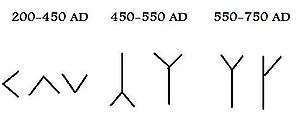Kaunan
The k-rune ᚲ (Younger Futhark ᚴ, Anglo-Saxon futhorc ᚳ) is called Kaun in both the Norwegian and Icelandic rune poems, meaning "ulcer". The reconstructed Proto-Germanic name is *Kauną. It is also known as Kenaz ("torch"), based on its Anglo-Saxon name.
| Name | Proto-Germanic | Old English | Old Norse |
|---|---|---|---|
| *Kauną? | Cēn | Kaun | |
| ? | "torch" | "ulcer" | |
| Shape | Elder Futhark | Futhorc | Younger Futhark |
| Unicode | ᚲ U+16B2 | ᚳ U+16B3 | ᚴ U+16B4 |
| Transliteration | k | c | k |
| Transcription | k | c | k, g |
| IPA | [k] | [k], [c], [tʃ] | [k], [g] |
| Position in rune-row | 6 | ||

The Elder Futhark shape is likely directly based on Old Italic c (![]()
![]()
The shape of the Younger Futhark kaun rune (ᚴ) is identical to that of the "bookhand" s rune in the Anglo-Saxon futhorc. The ᚴ rune also occurs in some continental runic inscriptions. It has been suggested that in these instances, it represents the ch /χ/ sound resulting from the Old High German sound shift (e.g. ᛖᛚᚴ elch in Nordendorf II).[1]
| Rune Poem:[2] | English Translation: |
|
Old Norwegian
|
|
|
Old Icelandic
|
|
|
Anglo-Saxon
|
|
Notes:
| |
References
- Tineke Looijenga, Texts & contexts of the oldest Runic inscriptions, BRILL, 2003, ISBN 978-90-04-12396-0, p. 129.
- Original poems and translation from the Rune Poem Page.